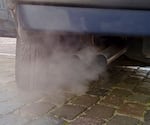After years of trying and failing to launch a cap and trade program to reduce carbon emissions economy-wide, Oregon has a new plan to cut some of its biggest sources of climate pollution.
Under orders from Gov. Kate Brown, the Oregon Department of Environmental Quality developed a new set of rules that would cap greenhouse gas emissions from fossil fuels and reduce them over time.
The proposed Climate Protection Program would cut emissions from suppliers of gasoline, diesel, propane, kerosene and natural gas 80% by 2050. By capping emissions from fuels, it targets the state’s largest source of carbon dioxide emissions; cars, trucks and other forms of transportation made up 36% of emissions in 2019.
Under the new rules, companies distributing more than a set amount of fossil fuels would have to reduce their emissions to meet a declining cap. To meet the target, they would be allowed to bank and trade emission credits that could come from switching to renewable fuels or electricity.

Transportation-related emissions amounted to around 36% of all carbon dioxide emissions in Oregon in 2019.
Ruben de Rijcke / Wikimedia Commons
They would also be able to pay for emission reductions in communities that are most vulnerable to climate change through an investment fund that could help cover the cost of switching to an electric vehicle or reducing home energy use.
DEQ Director Richard Whitman said The Community Climate Investment Fund is designed to be a smarter alternative to the controversial carbon offset options that other programs like California’s cap and trade system have that allow polluters to pay for things like sequestering carbon in forests instead of reducing emissions.
“These dollars have to be spent to actually reduce emissions in the communities that are most at risk,” Whitman said. “What we do not want to see happen is lower-income communities, whether they’re urban or rural, get stuck at the end of this 30-year period with old clunker cars that burn a lot of gas and homes that are drafty and burn natural gas or propane. Those households really get stuck at the end with potentially paying higher prices.”
Industry groups say price increases for gasoline, diesel and natural gas will put Oregon businesses at a competitive disadvantage and could drive them out of state.
Mike Freese, who represented the Oregon Fuels Association on DEQ’s rulemaking advisory committee, said the threshold for fuel distributors that are subject to the new rules is low enough to include small suppliers that aren’t oil industry giants.
“These are Oregon companies,” he said. “A lot of them are family-owned and have been for a long time, and they may have a branded station but Chevron doesn’t own the station.”
Capping emissions at the distribution level could lead to supply shortages and skyrocketing prices for both fossil fuels and biofuels, Freese said.
“They could build in provisions so we don’t make fuel so expensive it’s unaffordable,” he said. “Other programs like this have off-ramps. Why we don’t have one here is hard to understand.”
Whitman said the program allows some flexibility in how companies meet the cap, but there’s no plan to let them off the hook.
“We’re not just talking about targets here that we hope we’ll meet,” Whitman said. “These are hard caps. There’s going to be legal consequences for not meeting them.”

California has already started banning older diesel engines, which has raised concerns that companies will sell their old trucks into Oregon.
Cassandra Profita/EarthFix
Jana Jarvis, president of Oregon Trucking Associations, said the program will significantly increase the cost of the diesel fuel her industry depends on.
“Our problem in this industry is there is no economically viable electric vehicle for us to use,” she said. “So much of what DEQ is doing through this rulemaking will simply add cost without any environmental benefit.”
Whitman argues there’s enough time built into the plan to allow companies to adapt before things get dire.
“We’re not talking about switching people to electric trucks tomorrow,” he said. “We’re talking about a 30-year effort here. I was thinking just a little while ago: Where was I 30 years ago and what’s changed over the past 30 years? That’s how people need to be thinking about this.”
But environmental advocates point to new science that says the world can’t wait 30 years to dramatically reduce the emissions that are warming the planet and driving the devastating heat waves and wildfires that Oregon is now seeing.
A new report from the U.N. Intergovernmental Panel on Climate Change advises a 50% cut in greenhouse gas emissions in the next decade to avoid the worst impacts of climate change.

A man stops on his bike along the Willamette River as smoke from wildfires partially obscures the Tilikum Crossing Bridge, Saturday, Sept. 12, 2020, in Portland, Ore.
John Locher / AP
Nora Apter, climate program director for the Oregon Environmental Council, said DEQ’s plan should follow that science and require a more aggressive reduction in emissions.
“We’ve all lived through the climate disasters of the past year and a half,” Apter said. “Even since this rulemaking kicked off, you know, we’ve unwantedly become the poster child for climate change worldwide, grabbing international headlines because of our climate-fueled wildfires, the unprecedented heatwaves and drought.”
DEQ’s new program would also require 13 industrial facilities to develop plans for reducing pollution using the best available emissions reductions tools. Apter said that part of the plan falls short because it doesn’t include any mandatory reductions.
“They might need some kind of a permit or report on their emissions, but there wouldn’t be a requirement for them to reduce them,” she said.
Whitman said the natural gas many industrial facilities use will be covered under the program’s caps, so some industries will be regulated indirectly by those rules in addition to the requirements to implement the best available emissions reductions.
The rules could also change as DEQ finalizes them for approval by the Environmental Quality Commission. A staff recommendation will weigh in on calls to make the program targets more or less aggressive, Whitman said, and the EQC will make the final decision.
Earlier in its development, the program was criticized for leaving out natural gas-fired power plants, but those will now be regulated under an ambitious new law that would cut emissions from electric utilities down to zero by 2040.
Whitman said existing regulations like the Oregon Clean Fuels Program and requirements to phase out coal-fired power are already reducing emissions. A modeling study found that the state is already on track to achieve a 30% reduction in greenhouse gas emissions by 2050 with existing programs.
An assessment of the Clean Fuels Program shows the mandatory 5% reduction in carbon intensity resulted in fuel price increases of about 4 cents per gallon. That program is scheduled to ramp up to a 25% reduction by 2035, Whitman said, and that’s going to be part of meeting the larger goal of 80% reductions by 2050.
“There’s a lot of fear about this and I understand that,” Whitman said. “We have analyzed this, and we feel confident that there is a way to get there. But we’re running out of time. It’s time to get started. We’ll continue to tweak this as we need to, to improve it. If we run into problems we’ll work with people to fix them.”
DEQ is taking public comments on the proposed rules through Oct. 25.


